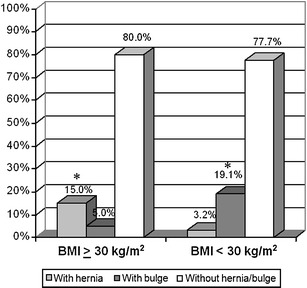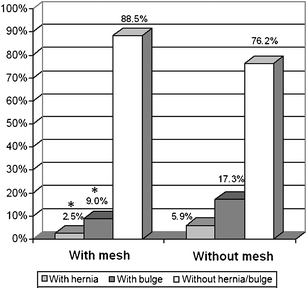Factors associated with hernia and bulge formation at the donor site of the pedicled TRAM flap
- PMID: 20694032
- PMCID: PMC2905518
- DOI: 10.1007/s00238-010-0418-4
Factors associated with hernia and bulge formation at the donor site of the pedicled TRAM flap
Abstract
The purpose of this study was to evaluate the correlation between risk factors and hernia or bulge formation at the donor site of the transverse rectus abdominis myocutaneous (TRAM) flap. A retrospective study was conducted between September 2005 and December 2008 in 206 patients who underwent breast reconstruction with pedicled TRAM flap. Eight (3.9%) of these patients had abdominal wall hernia and 26 (12.6%) had abdominal bulging. The incidence of hernia was significantly higher (P < 0.05) among patients with body mass index (BMI) >/= 30 kg/m(2) (hernia incidence, 15.0%) than that among patients with BMI <30 kg/m(2) (hernia incidence, 3.2%), while the incidence of abdominal bulge was significantly lower (P < 0.05) among patients with BMI >/= 30 kg/m(2) (abdominal bulge incidence, 5.0%) than that among patients with BMI >/= 30 kg/m(2) (abdominal bulge incidence, 19.1%). Therefore, obesity was identified as a risk factor for abdominal wall hernia. It was also found that the use of mesh to reinforce the abdominal wall significantly reduced (P < 0.025) the incidence of hernia (use of mesh (hernia incidence, 2.5%) versus non-mesh (hernia incidence, 5.9%)) and abdominal bulge (use of mesh (abdominal bulge incidence, 9.9%) versus non-mesh (abdominal bulge incidence, 17.3%)) among the patients.
Figures


Similar articles
-
Technique for Minimizing Donor-site Morbidity after Pedicled TRAM-Flap Breast Reconstruction: Outcomes by a Single Surgeon's Experience.Plast Reconstr Surg Glob Open. 2015 Aug 3;3(8):e476. doi: 10.1097/GOX.0000000000000451. eCollection 2015 Aug. Plast Reconstr Surg Glob Open. 2015. PMID: 26495189 Free PMC article.
-
The use of mesh versus primary fascial closure of the abdominal donor site when using a transverse rectus abdominis myocutaneous flap for breast reconstruction: a cost-utility analysis.Plast Reconstr Surg. 2015 Mar;135(3):682-689. doi: 10.1097/PRS.0000000000000957. Plast Reconstr Surg. 2015. PMID: 25719690 Review.
-
Inclusion of mesh in donor-site repair of free TRAM and muscle-sparing free TRAM flaps yields rates of abdominal complications comparable to those of DIEP flap reconstruction.Plast Reconstr Surg. 2010 Aug;126(2):367-374. doi: 10.1097/PRS.0b013e3181de1b7e. Plast Reconstr Surg. 2010. PMID: 20679822
-
Postoperative Abdominal Bulge and Hernia Rates in Patients Undergoing Abdominally Based Autologous Breast Reconstruction: Systematic Review and Meta-Analysis.Ann Plast Surg. 2021 Apr 1;86(4):476-484. doi: 10.1097/SAP.0000000000002538. Ann Plast Surg. 2021. PMID: 33720921
-
Comprehensive analysis of donor-site morbidity in abdominally based free flap breast reconstruction.Plast Reconstr Surg. 2013 Dec;132(6):1383-1391. doi: 10.1097/PRS.0b013e3182a805a3. Plast Reconstr Surg. 2013. PMID: 24005365
Cited by
-
Utilizing NPWT improving skin graft taking in reconstruction for extended breast skin defects following mastectomy.Clin Case Rep. 2021 Oct 4;9(10):e04716. doi: 10.1002/ccr3.4716. eCollection 2021 Oct. Clin Case Rep. 2021. PMID: 34631060 Free PMC article.
-
Unilateral and Bilateral Breast Reconstruction with Pedicled TRAM Flaps: An Outcomes Analysis of 188 Consecutive Patients.Plast Reconstr Surg Glob Open. 2013 Jun 7;1(2):1-7. doi: 10.1097/GOX.0b013e3182944595. eCollection 2013 May. Plast Reconstr Surg Glob Open. 2013. PMID: 25289209 Free PMC article.
-
Technique for Minimizing Donor-site Morbidity after Pedicled TRAM-Flap Breast Reconstruction: Outcomes by a Single Surgeon's Experience.Plast Reconstr Surg Glob Open. 2015 Aug 3;3(8):e476. doi: 10.1097/GOX.0000000000000451. eCollection 2015 Aug. Plast Reconstr Surg Glob Open. 2015. PMID: 26495189 Free PMC article.
-
Simultaneous Breast and Nipple-Areolar Reconstruction Using Musculo-derma-glandular, Axio-perforator, Bipedicled Flap.Plast Reconstr Surg Glob Open. 2021 Nov 22;9(11):e3963. doi: 10.1097/GOX.0000000000003963. eCollection 2021 Nov. Plast Reconstr Surg Glob Open. 2021. PMID: 34815925 Free PMC article.
-
Donor-Site Complications and Remnant of Rectus Abdominis Muscle Status after Transverse Rectus Abdominis Myocutaneous Flap Reconstruction.Plast Reconstr Surg Glob Open. 2017 Jun 29;5(6):e1387. doi: 10.1097/GOX.0000000000001387. eCollection 2017 Jun. Plast Reconstr Surg Glob Open. 2017. PMID: 28740793 Free PMC article.
References
LinkOut - more resources
Full Text Sources
